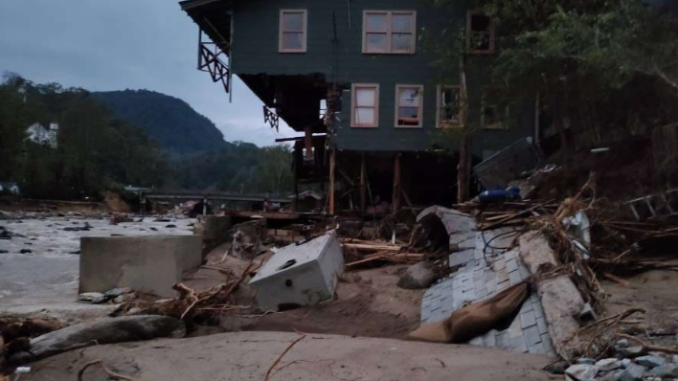
Residents of a tiny North Carolina town that was almost totally destroyed by Hurricane Helene fending for themselves after FEMA told them that a “road closed” sign is an insurmountable obstacle for the agency to navigate.
“FEMA called me and told me they wanted to inspect my house then called me back to say they couldn’t drive around the ‘road closed’ sign. They weren’t allowed,” local Chelsea Atkins, 38, told The Post.
{snip}
Left to fend for themselves, Bat Cave residents banded together — opening the roads and starting the arduous work of cleanup and recovery. Residents told The Post that they don’t need FEMA now — and at this point, they don’t even want the disaster relief agency to come.
While the sick and elderly residents of Bat Cave were airlifted to safety a week ago, those left behind have seen virtually no sign of government agencies, save for a handful of Louisiana State Police troopers “keeping an eye on everything,” who locals say haven’t done much of anything.
{snip}
Here, apple orchard workers armed with chainsaws worked with a local grading contractor to clear the roadways well before the Department of Transportation arrived to help, although they were grateful for the assist when it finally arrived.
Helene’s path of destruction
- Helene slammed into Florida’s Big Bend coastline Thursday night as a Category 4 hurricane, pounding the state with 155-mph gusts and killing at least 13.
- Helene moved northeast into Georgia, where it was downgraded to a tropical storm by Friday morning, but winds and floods left 25 dead in the state.
- By Friday afternoon, Helene had moved over parts of Tennessee, Virginia, North Carolina and South Carolina, where at least 29 died.
- Relentless rain drenched Appalachia Friday night, sending floodwaters and mudslides crashing through mountain towns.
- In North Carolina, at least 35 people died in the Asheville area, and a tornado injured 15 in Rocky Mount.
- Over the weekend, rescuers struggled to clear roads and recover bodies. The death toll is 192 and counting.
The few remaining locals have scavenged building supplies to shore up homes teetering on the edge of the Broad River, which is now ten times wider than it was before Helene carved its path of destruction.
Atkins, a health researcher, originally from Buffalo, NY, said she thought she was going to die when the storm hit Bat Cave. She and her husband Andy Wells, 40, sought shelter Friday morning in the foyer of a small white brick post office across Highway 64 with neighbors Kendall and her fiancée Curtis McCart, 58.
“It was wild,” Atkins said.
When floodwaters started to deluge their makeshift refuge, the displaced locals next made their way to empty houses on higher ground, trudging up the side of a mountain in a desperate attempt to reach safety.
{snip}
“At first we thought we’d be fine waiting out the storm in the post office for a couple of hours and then walk back home. With every minute that went by, the situation got more and more dire,” she said.
“The post office flooded and that’s when we realized the s—t was really hitting the fan.”
Atkins says she’s not usually frightened by weather, but admits at this point she genuinely feared for her life.
“I’m not very ruffled by nature, I can really handle a lot, but I looked at my neighbor and asked ‘are we going to die?’, like real talk ‘are we going to die?’.
The next cabin the group tried had a screened-in porch and provided them with the shelter they had sought.
Atkins said FEMA called her to arrange an inspection of her house on the Broad River rendered uninhabitable by the storm, but that they never showed up because the road was closed — the very same road The Post successfully traversed on its way to Bat Cave.
{snip}
“FEMA hasn’t been here,” Atkins said.
“The DOT’s been here, and random fire departments, like Kannapolis. They were great. But nobody’s been bringing in supplies except civilians,” she shared.
At this late stage in the recovery effort, Atkins said there are concerns FEMA showing up at this point could do more harm than good.
“It’s been a civilian-run operation since day one. You can’t ask the authorities for help — they’ll say you need to leave,” she said, calling Bat Cave a “country-boy can survive” kind of place.
“We’re handling it. Leave it to us and we’ll get it covered.”
Her neighbor Curtis McCart, a retired Los Angeles fire department captain and paramedic, estimates a dozen houses along his stretch of the winding Highway 64 were washed away in the storm.
{snip}
The Broad River was only 10 yards wide in front of McCart’s home before the hurricane. Now it’s a 100-yard-wide riverbed strewn with trees, concrete slabs, twisted tin and powerlines with their transformers still connected.
“We had huge 60-feet tall sycamores in front of the house, which must have been 100-and-something years old, that are all gone. Because of their age, they must have been here in the 1916 flood which I heard was 27-30 feet. This flood must have been worse, I heard this flood was 40-feet,” he said.
McCart hasn’t seen anyone in Bat Cave wearing a FEMA uniform, and like Atkins, he also worries about what will happen if they show up as he works to buttress the third floor of his home to stop the attic roof from toppling.
{snip}
The unincorporated community — with a population of just 180 residents — is about 30 miles southeast of Asheville.
At least 232 people in the Southeast lost their lives in Hurricane Helene so far, with hundreds still reported missing.
The Category 4 storm was the deadliest mainland US hurricane since Katrina rocked the Gulf Coast in 2005.
* Original Article:
https://nypost.com/2024/10/06/us-news/fema-abandons-residents-of-devastated-nc-town-because-of-road-closed-sign/?utm_source=smartnews&utm_campaign=nypost&utm_medium=referral